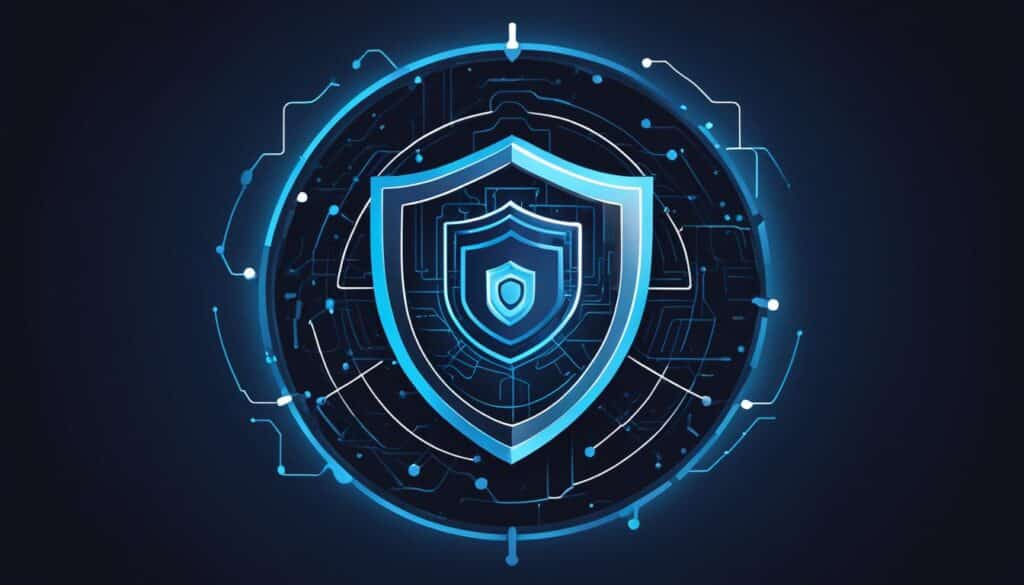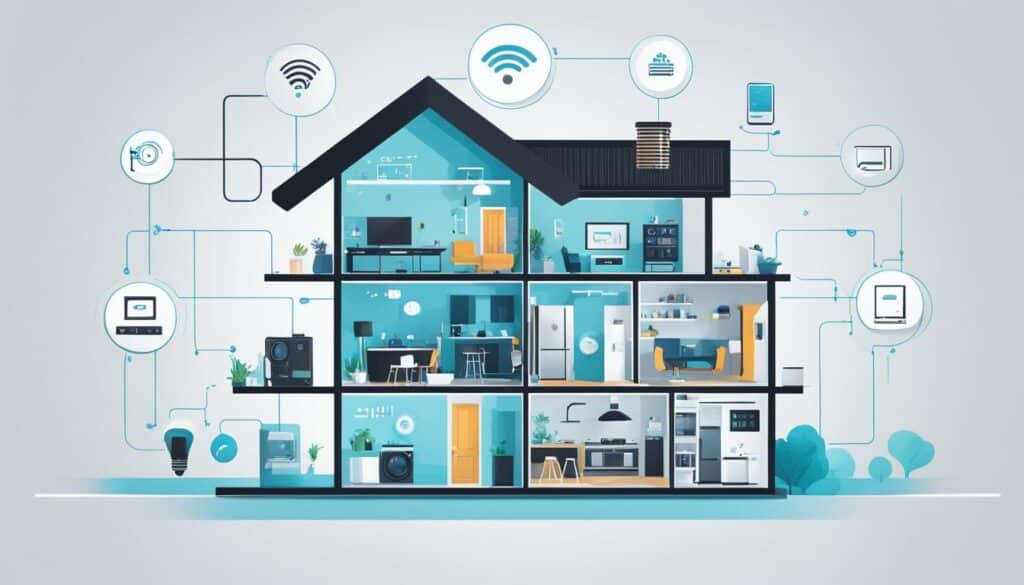Technology has transformed the way we live, and one of the most exciting advancements is in the realm of smart homes. With the Internet of Things (IoT), homeowners can now enjoy the convenience and control of managing their homes with just a few taps on their smartphones or even through voice commands. In this article, I will provide a beginner’s guide to IoT for smart homes, exploring the basics of this technology and how it is revolutionizing the way we experience our living spaces.
Table of Contents
Key Takeaways:
- IoT enables homeowners to connect and control various devices and appliances in their homes through a mobile app or voice commands.
- Home automation, energy efficiency, and improved security are some of the benefits that IoT brings to smart homes.
- Privacy concerns, compatibility, and cybersecurity are important factors to consider when implementing IoT technology.
- The future of IoT in smart homes includes integration with AI, voice assistants, and smart home ecosystems.
- Embracing IoT allows beginners to unlock the full potential of smart home technology and enhance their quality of life.
What is IoT and How Does It Work?
IoT, short for Internet of Things, is a vast network of interconnected physical devices, vehicles, appliances, and other objects that are embedded with sensors, software, and connectivity capabilities. This network allows these devices to connect and exchange data, creating a seamless environment of smart devices.
In the context of smart homes, IoT technology enables various devices to communicate with each other and be controlled remotely. This connectivity enhances the functionality and convenience of smart homes, providing homeowners with a range of benefits.
Imagine being able to adjust your home’s temperature, control the lighting system, monitor security cameras, and operate appliances through a single mobile app or voice commands. With IoT, this is all possible. The interconnectedness of devices ensures that they work together harmoniously, creating a seamless and personalized experience for homeowners.
https://www.youtube.com/watch?v=SfbOTZTzQt4
By automating tasks and allowing remote control, IoT technology eliminates the need for manual intervention, saving time and effort. Whether you’re away from home or simply want to relax, you can have peace of mind knowing that your smart devices are functioning according to your preferences.
With IoT, the possibilities are endless. You can customize your smart home to suit your lifestyle and routines:
- Set the thermostat to automatically adjust to your preferred temperature when you wake up or return home.
- Dim or brighten the lights to create the perfect ambiance for different occasions.
- Receive real-time notifications and monitor security cameras to ensure the safety of your home, even when you’re away.
- Control appliances and create schedules to optimize energy usage and reduce utility bills.
Ultimately, IoT technology empowers homeowners with control, convenience, and efficiency. By harnessing the power of connectivity, smart devices transform houses into intelligent homes.
Benefits of IoT in Smart Homes
The integration of IoT technology into smart homes brings numerous benefits to homeowners. One of the main advantages is home automation. With smart home automation, devices can be programmed to perform tasks automatically, simplifying daily routines and enhancing convenience.
A key aspect of home automation is the ability to control various aspects of the home, such as adjusting the temperature. Smart thermostats can learn your preferences and automatically regulate the temperature, ensuring comfort while optimizing energy usage. This leads to increased energy efficiency and cost savings, as homeowners can reduce energy wastage and ultimately lower their utility bills.
Efficient and convenient lighting is another benefit of IoT in smart homes. Connected lighting systems can be controlled remotely, allowing homeowners to turn on/off lights as needed, even when they are not at home. This feature enhances energy efficiency by avoiding unnecessary energy consumption and provides an added layer of security by giving the illusion of an occupied home.
When it comes to home security, IoT plays a crucial role. Smart home security systems offer advanced features such as remote surveillance, smart locks, and motion sensors. Homeowners can monitor their property through real-time video feeds, receive instant notifications of any suspicious activity, and even lock or unlock doors remotely. These smart security devices provide peace of mind and a heightened sense of security.
Furthermore, IoT technology enhances convenience and comfort by enabling voice control and remote access. Voice assistants such as Amazon Alexa or Google Assistant integrate seamlessly with smart home devices, allowing homeowners to control various functions using voice commands. Whether it’s adjusting the thermostat, playing music, or setting reminders, voice control simplifies daily tasks and creates a more personalized living experience. Remote access enables homeowners to monitor and manage their smart homes from anywhere, providing unparalleled convenience and peace of mind.
Combining all these benefits, IoT transforms traditional homes into intelligent, energy-efficient, and secure environments. Homeowners can personalize their settings, automate tasks, and enjoy a simplified lifestyle with the power of IoT technology.
Comparing Benefits of IoT in Smart Homes
| Benefits | Description |
|---|---|
| Home Automation | Devices can be programmed to perform tasks automatically, enhancing convenience and simplifying routines. |
| Energy Efficiency | Smart home automation optimizes energy usage, resulting in reduced utility bills and a greener environmental footprint. |
| Security | IoT-powered security systems offer remote surveillance, smart locks, and motion sensors, providing enhanced protection and peace of mind. |
| Voice Control | Integration with voice assistants allows homeowners to control smart devices through simple voice commands, creating a hands-free and personalized experience. |
| Remote Access | Homeowners can monitor and manage their smart homes remotely, ensuring convenience and peace of mind from anywhere. |
Challenges and Considerations in Implementing IoT for Smart Homes
While IoT technology brings numerous advantages to smart homes, it also presents challenges that homeowners need to consider. These challenges revolve around privacy concerns, compatibility issues, and cybersecurity risks.
Privacy Concerns
One of the major concerns with implementing IoT in smart homes is the collection and sharing of personal data by connected devices. As these devices gather information about our daily routines and habits, there is a potential risk of this data falling into the wrong hands or being used for unauthorized purposes. Protecting our privacy becomes crucial in creating a secure smart home environment.
Compatibility Issues
An additional challenge arises from the compatibility between different brands and protocols used in IoT devices. With so many manufacturers offering smart home products, it’s essential for homeowners to ensure that their devices are compatible with each other. This compatibility issue can sometimes lead to difficulties in establishing seamless communication and integration between devices, hindering the overall functionality of the smart home system.
Cybersecurity Risks
Cybersecurity is of utmost importance when implementing IoT in smart homes. As connected devices become more prevalent, they also become potential targets for hackers. Weak security measures or outdated software can expose vulnerabilities in the system, allowing unauthorized access to personal information and control of the smart home. It is crucial to prioritize cybersecurity by implementing strong encryption, regularly updating devices, and safeguarding the network from potential threats.
“The more connected devices we have in our homes, the greater the surface area for potential cyber-attacks. It’s essential to be proactive and take necessary security measures when implementing IoT in smart homes.”
To mitigate these challenges and address them effectively, homeowners should prioritize privacy, carefully review the compatibility of devices before purchasing, and implement robust cybersecurity measures. By doing so, they can ensure a safe and seamless smart home experience.

Future Trends and Innovations in IoT for Smart Homes
The future of IoT in smart homes is filled with exciting possibilities. As technology continues to advance, the integration of artificial intelligence (AI) will play a significant role in enhancing the functionality and intelligence of smart devices, making our lives even more seamless.
One of the key innovations in IoT is the integration of AI algorithms and machine learning capabilities into smart home devices. This enables them to learn and adapt to homeowners’ preferences over time, creating personalized experiences and automating routine tasks. Imagine waking up to a home that knows your preferred lighting and temperature settings, prepares your morning coffee automatically, and adjusts the blinds to let in the perfect amount of natural light.
Another prominent trend in the future of IoT for smart homes is the rise of voice assistants. Voice-controlled devices, such as Amazon Alexa and Google Assistant, will become more prevalent in households, allowing homeowners to control their smart devices through simple voice commands. With just a few words, you can turn on the lights, play music, adjust the thermostat, and even order groceries online.
Additionally, the development of smart home ecosystems will further enhance the integration and interoperability of devices from different manufacturers. This means that devices such as smart TVs, refrigerators, and security systems can seamlessly connect and communicate with each other, creating a unified and synchronized home experience.

The Benefits of AI Integration in Smart Homes
“AI integration in smart homes allows devices to learn and adapt to homeowners’ preferences, providing personalized experiences and simplifying daily routines.”
With the integration of AI, voice assistants, and smart home ecosystems, the future of IoT in smart homes is poised to transform the way we live, offering enhanced convenience, efficiency, and control.
Conclusion
As IoT technology continues to advance, it is becoming increasingly accessible and user-friendly for homeowners. The integration of IoT in smart homes brings a multitude of benefits, making our lives more convenient, efficient, and secure. By connecting various devices and appliances, IoT enables homeowners to automate tasks, control their homes remotely, and personalize their living experiences.
One of the key advantages of IoT in smart homes is increased convenience. With IoT technology, homeowners can easily control their devices through mobile apps or voice commands, eliminating the need for manual operation. This includes adjusting the temperature, turning on/off lights, and managing energy usage. The automation provided by IoT not only enhances convenience but also leads to improved energy efficiency and cost savings.
Security is another crucial aspect that IoT brings to smart homes. With features like remote surveillance, smart locks, and motion sensors, homeowners can bolster the security of their properties. They can monitor their homes from anywhere, receiving alerts in case of unusual activities or breaches. However, it is important to address privacy concerns and implement strong cybersecurity measures to ensure the safe and secure operation of IoT devices.
The future of IoT in smart homes holds immense potential. The integration of artificial intelligence (AI) will enable devices to learn and adapt to homeowners’ preferences, creating a more personalized and seamless experience. Voice assistants, such as Amazon Alexa and Google Assistant, will play a crucial role in controlling smart devices, allowing for hands-free operation and effortless management. Additionally, the development of smart home ecosystems will enable different devices from various manufacturers to work together seamlessly, enhancing interoperability and expanding the possibilities of home automation.
By embracing IoT, beginners can unlock the full potential of smart home technology. With its numerous advantages and ongoing innovations, IoT for smart homes will continue to simplify and enhance the way we live, making our homes smarter, more efficient, and safer.
FAQ
What is IoT?
IoT stands for the Internet of Things. It refers to the network of physical devices, vehicles, appliances, and other objects that are embedded with sensors, software, and connectivity capabilities to enable them to connect and exchange data.
How does IoT work in smart homes?
In the context of smart homes, IoT enables various devices such as thermostats, lighting systems, security cameras, and appliances to communicate with each other and be controlled remotely through a mobile app or voice commands.
What are the benefits of using IoT in smart homes?
The integration of IoT technology into smart homes brings numerous benefits, including home automation, increased energy efficiency, improved home security, and enhanced convenience and comfort.
What are the challenges in implementing IoT for smart homes?
Some challenges to consider when implementing IoT in smart homes include privacy concerns, compatibility between different brands and protocols, and the need for strong cybersecurity measures to prevent unauthorized access.
What are the future trends and innovations in IoT for smart homes?
The future of IoT in smart homes holds exciting possibilities, including integration with artificial intelligence (AI), the prevalence of voice assistants for smart devices, and the development of smart home ecosystems that enhance interoperability.
How can beginners unlock the full potential of smart home technology?
By embracing IoT technology, beginners can experience the benefits of increased convenience, energy efficiency, and security in their smart homes. They should also consider the challenges and ensure proper security measures are in place.
Source Links
- https://www.nstec.com/upgrade-your-wifi-security-a-step-by-step-guide-to-switching-to-wpa2/
- https://www.objetconnecte.com/data-studio-sensiml-corporation/
- https://www.linkedin.com/pulse/unveiling-future-silicon-platform-service-sipaas-b4wwf?trk=article-ssr-frontend-pulse_more-articles_related-content-card


